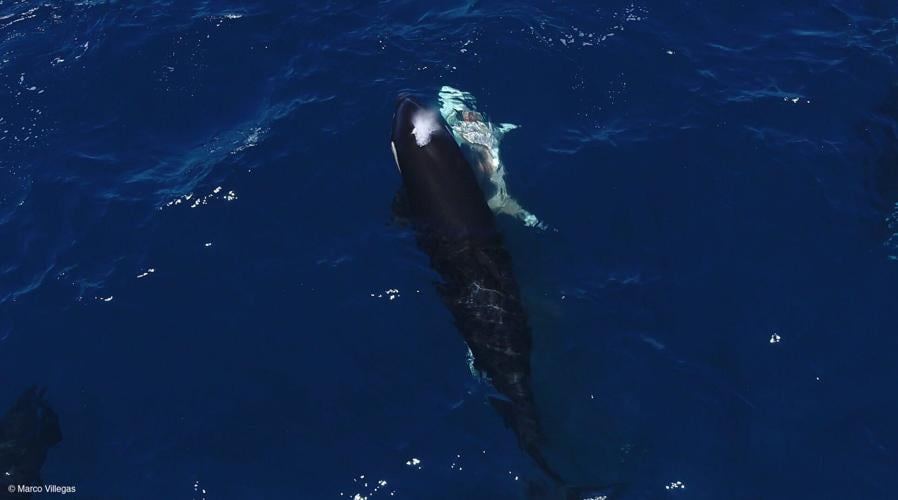By Stephen Beech
Killer whales have been caught on camera hunting down and eating great white sharks alive.
A shark-hunting pod of orcas was seen flipping their rival apex predators upside-down to paralyze them - before feasting on their energy-rich livers.
Marine scientists - who named the specialist hunters "Moctezuma’s Pod" - say they could be taking advantage of warming waters in the Gulf of California, altering traditional shark nursery areas to hunt juveniles.
The research team says their observations, published by the journal Frontiers in Marine Science, suggest that orcas may hunt white sharks more often than previously realised.
Marine biologist Erick Higuera Rivas, lead author of the study, said: “I believe that orcas that eat elasmobranchs - sharks and rays - could eat a great white shark, if they wanted to, anywhere they went looking for one.
“This behavior is a testament to orcas’ advanced intelligence, strategic thinking, and sophisticated social learning, as the hunting techniques are passed down through generations within their pods.”

An orca subdues a white shark. (Marco Villegas via SWNS)
The scientists spotted two hunts, killing three white sharks, during routine monitoring of the orcas.
They recorded the hunts in detail, identifying the individual killer whales involved from features on their dorsal fins.
During the first hunt, in August 2020, five orcas were seen pursuing a juvenile white shark.
They pushed it to the surface and worked together to turn it upside down.
Ultimately, they took it underwater and reappeared with the shark’s liver in their mouths.
Then, shortly afterwards, they did the same with a second juvenile shark.
A second hunt, witnessed in August 2022, followed a similar pattern: five orcas pushed a juvenile white shark onto its back and up to the surface.
The shark was bleeding from its gills, and its liver was visible - with the orcas seen eating it.

An orca strikes a shark in the belly. (Marco Villegas via SWNS)
Turning a shark upside down induces a state called "tonic immobility" - changing its awareness of its surroundings in a way that paralyzes it, explained the researchers.
Higuera Rivas said: “This temporary state renders the shark defenceless, allowing the orcas to extract its nutrient-rich liver and likely consume other organs as well, before abandoning the rest of the carcass."
After analysing the sharks’ injuries, researchers believe that orcas could have developed a specialized technique to induce this state, which minimizes the chances of being bitten.
They say it might be simpler to do so with smaller - and therefore younger - great white sharks, or less experienced juveniles might be easier prey.
Study co-author Dr. Salvador Jorgensen, of California State University, said: “This is the first time we are seeing orcas repeatedly target juvenile white sharks.
“Adult white sharks react quickly to hunting orcas, completely evacuating their seasonalâ¯gathering areas and not returningâ¯for months.
"But these juvenile white sharks may be naive to orcas.
"We just don'tâ¯know yet whether white shark anti-predator flight responses are instinctual or need to be learned.”
Moctezuma’s Pod had previously been spotted hunting rays as well as whale and bull sharks, and the research team believes they may have learned from their experiences how to tackle great white sharks.

An orca swims next to a shark with a visible wound. (Marco Villegas via SWNS)
They said changes in the distribution of white sharks in the Pacific may have presented Moctezuma’s Pod with an opportunity.
Climate events such as El Niño appear to have altered white shark nursery areas and increased their presence in the Gulf of California, which could mean that they are more exposed to the deadly orcas.
The research team is planning a detailed survey of the orca population’s diet, which would clarify whether they regularly hunt white sharks or if they focus on the juveniles when they’re available.
Co-author Dr. Francesca Pancaldi added, “So far, we have only observed this pod feeding on elasmobranchs. There could be more.
"Generating information about the extraordinary feeding behavior of killer whales in this region will lead us to understand where their main critical habitats are, so we can create protected areas and apply management plans to mitigate human impact.”























(0) comments
Welcome to the discussion.
Log In
Keep it Clean. Please avoid obscene, vulgar, lewd, racist or sexually-oriented language.
PLEASE TURN OFF YOUR CAPS LOCK.
Don't Threaten. Threats of harming another person will not be tolerated.
Be Truthful. Don't knowingly lie about anyone or anything.
Be Nice. No racism, sexism or any sort of -ism that is degrading to another person.
Be Proactive. Use the 'Report' link on each comment to let us know of abusive posts.
Share with Us. We'd love to hear eyewitness accounts, the history behind an article.